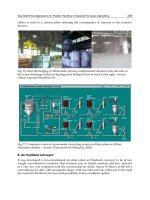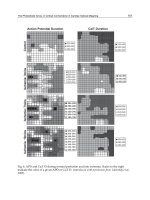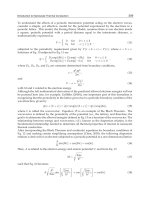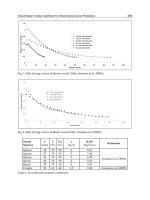Blood and Blood Transfusion - part 9 ppt
Bạn đang xem bản rút gọn của tài liệu. Xem và tải ngay bản đầy đủ của tài liệu tại đây (51.26 KB, 8 trang )
78
CRITICAL CARE FOCUS: BLOOD AND BLOOD TRANSFUSION
Acknowledgements
I am indebted to all the haemoglobin and myoglobin researchers at the
University of Essex for their contribution to the work presented in this
article, in particular Jackie Dunne, Brandon Reeder, Dimitri Svistunenko,
Peter Nicholls and Mike Wilson.
References
1 Babcock GT,Wikstrsˇm M. Oxygen activation and the conservation of energy in
cell respiration. Nature 1992;356:301–9.
2 Alderton WK, Cooper CE, Knowles RG. Nitric oxide synthases: structure,
function and inhibition. Biochem J 2001;357:593–615.
3 Kennedy JG, O’Grady P, McCarthy DR, et al. An investigation into the role of
oxygen free radical scavengers in preventing polymethylmethacrylate-induced
necrosis in an osteoblast cell culture. Orthopedics 2000;23:481–5.
4 Cooper CE. Ferryl iron and protein free radicals. In: Rice-Evans CA, Burdon
RH, eds. Free Radical Damage and its Control. Amsterdam: Elsevier 1994, 65–109.
5 Alayash AI, Patel RP, Cashon RE. Redox reactions of hemoglobin and myoglobin:
biological and toxicological implications. Antioxid Redox Signal 2001;3:313–27.
6 Svistunenko DA, Patel RP,Voloshchenko SV,Wilson MT.The globin-based free
radical of ferryl hemoglobin is detected in normal human blood. J Biol Chem
1997;272:7114–21.
7 Holt SGR, Moore K. Pathogenesis of renal failure in rhabdomyolysis: the role
of myoglobin. Exp Nephrol 2000;8:72–6.
8 Alayash AI. Hemoglobin-based blood substitutes and the hazards of blood
radicals. Free Rad Res 2000;33:341–8.
9 Holt SGR. Rhabdomyolysis. In: Galley HF, ed. Critical Care Focus, Volume 1:
Renal Failure. London: BMJ Books/Intensive Care Society 1999, 15–20.
10 Moore KP, Holt S, Patel RP, et al. A causative role for redox cycling of
myoglobin and its inhibition by alkalinization in the pathogenesis and treatment
of rhabdomyolysis-induced renal failure. J Biol Chem 1998;273:31731–7.
11 Holt S, Reeder B,Wilson M, et al. Increased lipid peroxidation in patients with
rhabdomyolysis. Lancet 1999;353:1241.
12 Reeder BJ, Wilson MT. The effects of pH on the mechanism of hydrogen
peroxide and lipid hydroperoxide consumption by myoglobin: a role for the
protonated ferryl species. Free Rad Biol Med 2001;30:1311–18.
13 Sanders KE, Ackers G, Sligar S. Engineering and design of blood substitutes.
Curr Opin Struct Biol 1996;6:534–40.
14 Winslow RM. Alpha-alpha-crosslinked hemoglobin: was failure predicted by
preclinical testing? Vox Sang 2000;79:1–20.
15 D’Agnillo F, Alayash AI. Site-specific modifications and toxicity of blood
substitutes.The case of diaspirin cross-linked hemoglobin. Adv Drug Deliv Rev
2000;40:199–212.
16 Dunne J, Svistunenko DA, Alayash AI, Wilson MT, Cooper CE. Reactions
of cross-linked methaemoglobins with hydrogen peroxide. Adv Exp Med Biol
1999;471:9–15.
17 Privalle C, Talarico T, Keng T, DeAngelo J. Pyridoxalated hemoglobin
polyoxyethylene: a nitric oxide scavenger with antioxidant activity for the
treatment of nitric oxide-induced shock. Free Rad Biol Med 2000;28:1507–17.
79
RADICAL REACTIONS OF HAEM PROTEINS
18 Eich RF, Li TS, Lemon DD, et al. Mechanism of NO-induced oxidation of
myoglobin and hemoglobin. Biochemistry 1996;35:6976–83.
19 Gross SS, Lane P. Physiological reactions of nitric oxide and hemoglobin: a
radical rethink. Proc Natl Acad Sci USA 1999;96:9967–9.
20 Doherty DH, Doyle MP, Curry SR, et al. Rate of reaction with nitric oxide
determines the hypertensive effect of cell-free hemoglobin. Nat Biotechnol
1998;16:672–6.
21 Rioux F, Harvey N, Moisan S, et al. Nonpeptide endothelin receptor antagonists
attenuate the pressor effect of diaspirin-crosslinked hemoglobin in rat. Can J
Physiol Pharmacol 1999;77:188–94.
22 Fischer SR, Traber DL. L-arginine and endothelin receptor antagonist
bosentan counteract hemodynamic effects of modified hemoglobin. Shock
1999;11:283–90.
23 Jia L, Bonaventura C, Bonaventura J, Stamler JS. S-Nitrosohemoglobin – a
dynamic activity of blood involved in vascular control. Nature 1996;380:221–6.
1
antitrypsin 40
ABO haemolytic transfusion reaction 30
activated protein C 39
neutralising antibodies 42, 45
therapy in severe sepsis 31, 41–7
complications 45
patient evaluation 42
results 42–5
acute coronary syndromes 11
acute lung injury (ALI) 49
transfusion-related see transfusion-related
acute lung injury
acute renal failure 72, 73
acute respiratory distress syndrome
(ARDS) 49
contribution of TRALI to 53–4
TRALI and 51–3
TRICC trial 10
aged blood 10–11
albumin
in interstitial fluid 57–8
solutions 57, 58, 64
animal studies 60–2
clinical studies 62–4
alkalinisation, in rhabdomyolysis 72, 73–5
allogeneic blood transfusion 13
in colorectal cancer 15, 16
American College of Physicians 1
angiogenesis, tumour 16–17
anticoagulants 32 see also heparin
anti-leucocyte antibodies, donor-derived
50–1, 53, 54
antithrombin (ATIII) 30–1
deficiency 30, 39
treatment 30–1, 35
aprotinin 32
ARDS see acute respiratory distress
syndrome
atherosclerosis 72
autologous blood transfusion 13
in colorectal cancer 15, 16
immunomodulatory effects 16
bleeding
complications, activated protein C
therapy 45, 46, 47
platelet count thresholds 25
time, testing 26–7
blood products 13
stored see stored blood products
units transfused 3, 4, 8
blood vessel injury, haemostatic reaction
23, 24
burn trauma
colloid infusions 63
leucocyte depleted blood 20, 21
Canadian Critical Care Trials Group
trial see Transfusion
Requirements in Critical
Care (TRICC) trial
capillary permeability 58
cardiac complications,TRICC trial 10
catalase 69, 76–7
coagulation
activation 23, 38
interaction with inflammation
39–40
in sepsis 39
colloid oncotic pressure, plasma
57–8
colloids 57–64
animal studies 59–62
clinical studies 62–4
synthetic 57
v crystalloids 58–9
81
Index
Page numbers in bold type refer to figures; those in italic refer to tables or boxed material
82
INDEX
colorectal cancer
leucocyte-depleted blood transfusion 17
post-operative infections and transfusion
14–15
tumour recurrence and transfusion
15–16
VEGF and metastases 16–17
complement activation 40
copper 67
coronary artery disease 2
cost-effectiveness
colloid and crystalloid solutions 59
restrictive transfusion strategy 10
cryoprecipitate 29
crystalloids 57, 58, 64
animal studies 59–60
v colloids 58–9
cytochrome c oxidase 67
cytokine receptor antagonists 32
cytokines
antibodies 32
inflammatory 38, 39
danaparoid 33
DBBF haemoglobin 76
D-dimers, plasma 42, 43–5, 46
1-deamino-8-D-arginine vasopressin
(DDAVP) 27
deep venous thrombosis (DVT) 34
dextrans 57, 64
DIC see disseminated intravascular
coagulation
disseminated intravascular coagulation
(DIC) 28–32
causes 28
therapy 29–32
drotrecogin alfa activated see activated
protein C
electron paramagnetic resonance (EPR)
71, 72–3, 74
endothelial cell protein C receptors
(EPCR) 39
endothelial cells
platelet regulation 24
protein C and 39–40
endotoxin 40
eosinophil cationic protein (ECP)
17, 18, 19,20
eosinophil protein X (EPX)
17, 18, 19,20
ethylene diamine tetra acetic acid (EDTA),
radio-labelled 61
extracellular fluid volume (ECFV) 63–4
F
2
-isoprostanes 73, 74,75
Factor VIIa 35
recombinant 27
Factor XIIa 35
fatty acids, polyunsaturated 67–8
Fenton chemistry 68
ferric/ferryl redox cycling
clinical relevance 72–7
reactions 69–71
ferrous haem proteins 69
fibrinogen concentrate 29
fibrinogen degradation products 29
fibrinolysis
protein C actions 40–1
in severe sepsis 39, 40
fluid
interstitial 57–8
for volume replacement 58–9
foetus, retained dead 30
free radicals
biological reactions 67–8
chemistry 66–7
haemoglobin based blood substitutes
75–6
identification/quantification 71
iron and 68
fresh frozen plasma 20, 29
gastrointestinal bleeding, transfusion
thresholds 3–4
gelatins 29, 57, 62, 64
glycerol treatment 72, 73
gut mucosal permeability 61
haemofiltration 35
haemoglobin
based blood substitutes 13, 59, 75–7
cell-free 75
concentration, transfusion thresholds
1–2, 3–4, 5, 11
DBBF 76
diaspirin-cross-linked 75
nitric oxide binding 75, 77
PHP 76
redox states 69–71
clinical relevance 72
haemolytic anaemia 72
haemostasis
mechanisms 23, 24
problems 23–35
haem proteins
radical formation 69
redox states 69–71
see also haemoglobin; myoglobin
83
INDEX
heating, stored blood 20
heparin
in DIC 30
induced thrombocytopenia 33
low molecular weight 34
venous thromboembolus prophylaxis 34
hip replacement surgery 14–15
hirudin 32
histamine 17, 19,20
hydrogen peroxide 69, 70, 75–6
hydroxyethyl starch (HES) 57, 62, 64
hydroxyl radicals 66–7, 68
hypertension 77
hypoalbuminaemia 63
hypovolaemia 63, 64
immunosuppression, transfusion-induced
2,3
allogeneic v autologous blood 16
leucocyte-depleted blood 17
infections
DIC 28
post-operative 13–14
blood transfusion and 14–15
leucofiltration and 20
see also sepsis
inflammation
interaction with coagulation 39–40
protein C actions 40, 46
role in ARDS 52
in sepsis 38, 39
in TRALI 53
interleukin-1 (IL-1) 39, 40
interleukin-2 (IL-2) receptor, soluble
16, 17
interleukin-6 (IL-6)
activated protein C therapy and
42, 43–5, 46
protein C actions 40
in transfused patients 17, 20, 21
interleukin-8 (IL-8) 39, 52–3
interleukin-10 (IL-1) 16
interstitial fluid 57–8
intra-abdominal surgery 13–14
intracranial haemorrhage 45
iron 67
free radicals and 68
redox states 69
lactated Ringer’s solution 59–60
lactoperoxidase 69
leucocyte depleted blood 11
bioactive substances 17, 18, 19
clinical benefits 20, 21
pre-storage v bedside leucofiltration
17–20
VEGF accumulation 17
leucocytes
donor-derived antibodies
50–1, 53, 54
role in ARDS 52
lipid peroxidation, myoglobin-induced
73, 74
lung cancer 16
meningococcaemia 31, 41
metastatic carcinoma, DIC 28, 30
methaemoglobin 69–70
metmyoglobin 70, 72–3
microcirculation
adverse effects of transfusion 2
colloid v crystalloid studies
59–60, 61
injury, in severe sepsis 39
protein C and 39–40
mitochondrial electron transport system
67
monocytes 40, 52
mortality
activated protein C trial 43, 44,45
ARDS 52
colloid solutions 62–3
colorectal cancer 15–16
severe sepsis 38
TRICC trial 8–10
multi-organ failure 39
muscle breakdown 72
myeloperoxidase
free radical formation 69
in stored blood products
17, 18, 19,20
myocardial function 62
myocardial infarction 10
myocardial injury 60, 72
myoglobin
radicals 70–1
redox states 69–71
in rhabdomyolysis 72–5
neutrophils 40, 52
nitric oxide 67, 68
haemoglobin binding 75, 77
nitrogen-based free radicals 68
oedema 58–9
orthopaedic surgery 14–15
oxidative stress 70–1, 75–7
oxygen-carrying resuscitation fluids 59
84
INDEX
oxygen delivery
augmenting 1, 2
effects of transfusion 3
index 63–4
oxygen-derived free radicals 66–7
oxyhaemoglobin 69, 77
packed cell volume, in DIC 29
paramagnetism 66
pentafraction 59, 60
pentastarch 59–60
perfluorocarbons 75
peroxide 66–7, 70
pH, ferryl myoglobin reactivity and 73–5
PHP haemoglobin 76
plasma 57
colloid oncotic pressure 57–8
fresh frozen 20, 29
proteins 57–8
plasma protein fraction (PPF) 62–3
plasma volume
after albumin v normal saline 63–4
expansion, colloids 57–64
plasminogen activator inhibitor-I (PAI-I)
in leucocyte-depleted blood 17, 19,20
protein C actions 40–1
in severe sepsis 39, 40
in stored blood products 17, 18
platelet(s) 23–8
acquired disorders 32–3
artificial 27–8
dysfunction, treatment options 27–8
endothelial cell regulation 24
function testing 26–7
refractoriness 25, 26, 26
transfusions 27, 29
platelet-activating factor (PAF) 40
platelet count 24–5
in DIC 28
refractoriness to transfusion
25, 26, 26
transfusion thresholds 25
see also thrombocytopenia
platelet function analyser 26–7
post-operative complications
infections 13–14
transfusion related 13–20
prostaglandin H synthase 69
protein C 31, 38
actions 40–1, 45–6
activated see activated protein C
deficiency
defined 42
in severe sepsis 31, 38, 39, 41, 43
microvasculature and 39–40
replacement therapy 31
proteins
free radical damage 68
plasma 57–8
P-selectin 40
pulmonary oedema 10
rat sepsis model 60–2
refusal rates,TRICC trial 6–7
renal failure, acute 72, 73
rhabdomyolysis 72–5
Ringer’s solution, lactated 59–60
saline, normal see sodium chloride, 0.9
saline-adenine-glucose-mannitol (SAGM)
blood 17, 18
sepsis 38–47
activated protein C therapy 31, 41–7
animal models 59–62
anticoagulants 32
antithrombin III therapy 30–1
colloid infusions 63–4
inflammatory response 38, 39
protein C deficiency 31, 38, 39,
41, 43
tissue factor pathway inhibitor therapy
31–2
see also infections
Serious Hazards of Transfusion (SHOT)
reporting system 50, 51
sheep sepsis model 59–60, 62
sickle cell anaemia 72
sodium chloride, 0.9(normal saline) 59
animal studies 60–2
clinical studies 63–4
Starling forces 58
stored blood products
bioactive substances 17, 18
heating 20
in TRICC trial 10–11
VEGF accumulation 17
stroke 72
subarachnoid haemorrhage 72
superoxide radical 66–7, 69–70
surgery, infections after see infections,
post-operative
survival see mortality
thrombin 35, 38, 39, 40
inhibition 30, 32
protein C actions 40–1, 46
thrombin-activatable fibrinolysis inhibitor
(TAFI) 40, 41
85
INDEX
thrombocytopenia
autoimmune idiopathic 33
heparin induced 33
immune 32–3
treatment options 27–8
thromboelastogram 26
thrombomodulin 39–40
thrombosis
deep venous (DVT) 34
fibrin-platelet 28
haemofiltration filters 35
protein C actions 40
vascular access 34–5
thrombotic tendency, factors promoting
34–5
thyroid peroxidase 69
tissue factor 38, 39, 40
inhibiting antibodies 32
tissue factor pathway inhibitor (TFPI)
24, 31–2
TRALI see transfusion-related acute lung
injury
tranexamic acid 27
transfusion
haemoglobin concentration thresholds
1–2, 3–4, 5, 11
platelet count thresholds 25
practice before TRICC trial 3–5
reasons against 2–3
reasons for 1–2, 3
transfusion-related acute lung injury
(TRALI) 49–55
acute inflammatory response and 53
ARDS and 51–3
causes 50–1
characteristics 49
clinical manifestations 50
contribution to ARDS 53–4
future research 55
incidence 51
laboratory investigations 54
treatment options 55
Transfusion Requirements in Critical Care
(TRICC) trial 1, 3–11
complications 10
demographic data 7–8
existing practice before 3–5
intervention data 8–10
interventions 5
recruitment 6–7
results 6–10
study design 5
trauma
transfusion and infection after 14
transfusion thresholds 3, 4
TRICC trial see Transfusion Requirements
in Critical Care (TRICC) trial
tumour necrosis factor ␣ (TNF␣) 16, 20
in ARDS 52
protein C actions 40
in severe sepsis 39, 40
tumours
angiogenesis and metastases 16–17
recurrence and transfusion 15–16
see also colorectal cancer
units of blood transfused 3, 4, 8
vascular access thrombosis 34–5
vascular endothelial growth factor (VEGF)
16–17
vascular injury, haemostatic reaction
23, 24
venous thromboembolus prophylaxis 34
white blood cells see leucocytes









